MONTENEGRO 2014
 Monday, May 18, 2015 at 07:05PM
Monday, May 18, 2015 at 07:05PM We went to Montenegro primarily because we couldn't think of any reason not to go to Montenegro. The trip was to begin in Sarajevo (Bosnia) and end in Dubrovnik (Croatia), two cities that interested us, and the ground we would need to cover between them seemed well within our capabilities. Our grasp of the political history of the former Yugoslavia was pitiful, and we hoped that being there might clarify things a little. (It didn't.) The only opinion that seemed to get wide acceptance was that everything had been better under Tito; he was able to keep the lid on most sectarian grievances, and once he departed from the scene, those erupted with horrifying savagery on all sides.
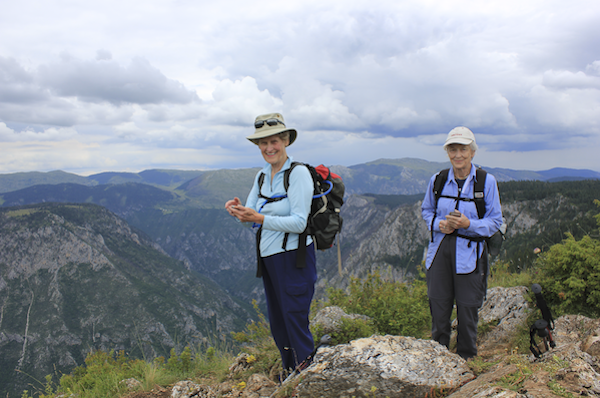 Suzy and EllieSarajevo bears more than its share of historic scars. It was there in June, 1914, that Archduke Franz Ferdinand of Austria was assassinated by Gavrilo Princip, a Serbian nationalist, precipitating a chain of events that led to the outbreak of the First World War. In still very living memory was the Siege of Sarajevo, the longest siege of a capital city in the history of modern warfare, lasting from 1992 to 1996. The city nestles in a deep bowl surrounded by hills. The location looks idyllic from the air, but on the ground you quickly get a sense of its vulnerability. For almost four years snipers held positions on the surrounding slopes, from which they had unobstructed views of anyone or anything that moved in the city. And their orders were to shoot to kill. It's impossible to ignore that brutal history when visiting Sarajevo.
Suzy and EllieSarajevo bears more than its share of historic scars. It was there in June, 1914, that Archduke Franz Ferdinand of Austria was assassinated by Gavrilo Princip, a Serbian nationalist, precipitating a chain of events that led to the outbreak of the First World War. In still very living memory was the Siege of Sarajevo, the longest siege of a capital city in the history of modern warfare, lasting from 1992 to 1996. The city nestles in a deep bowl surrounded by hills. The location looks idyllic from the air, but on the ground you quickly get a sense of its vulnerability. For almost four years snipers held positions on the surrounding slopes, from which they had unobstructed views of anyone or anything that moved in the city. And their orders were to shoot to kill. It's impossible to ignore that brutal history when visiting Sarajevo.
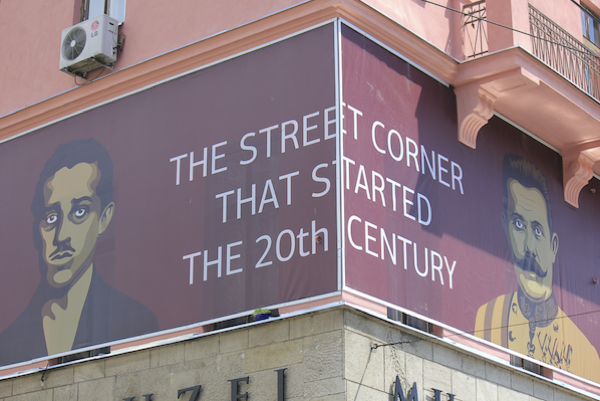 Site of the assassination of Archduke Franz Ferdinand in 1914We had one night on our own before we were to meet our group, and had been given the name of a restaurant worth a visit, on a hillside overlooking the city. It all began pleasantly enough. We foolishly chose to sit outside for the view, but were soon shivering. Seeing this, our waiter hastened over with heavy blankets to wrap around us. They weighed like something a sheepherder might need on a particularly cold night. We ordered veal, but what appeared didn't look like veal and when we pointed that out to our waiter, he allowed that it could be lamb. When we insisted that it didn't taste like lamb, he merely shrugged and suggested that it was probably fish. He did not offer to replace it, but to atone for any disappointment we might have been feeling he produced an enormous bunch of flowers and slammed them angrily onto our table. At the end of the meal we squandered any goodwill remaining between us by giving him a tip in a currency he didn't recognize. He threw the coins down on the table with an internationally understood gesture of disgust. As we learned one day too late, the independent countries formed after the breakup of Yugoslavia use distinct currencies; in Bosnia and Herzegovina it's the “convertible mark” or KM, in Montenegro the Euro, and in Dubrovnik (Croatia) the Duna. As we also later learned, tipping is not expected, so we considered it a draw.
Site of the assassination of Archduke Franz Ferdinand in 1914We had one night on our own before we were to meet our group, and had been given the name of a restaurant worth a visit, on a hillside overlooking the city. It all began pleasantly enough. We foolishly chose to sit outside for the view, but were soon shivering. Seeing this, our waiter hastened over with heavy blankets to wrap around us. They weighed like something a sheepherder might need on a particularly cold night. We ordered veal, but what appeared didn't look like veal and when we pointed that out to our waiter, he allowed that it could be lamb. When we insisted that it didn't taste like lamb, he merely shrugged and suggested that it was probably fish. He did not offer to replace it, but to atone for any disappointment we might have been feeling he produced an enormous bunch of flowers and slammed them angrily onto our table. At the end of the meal we squandered any goodwill remaining between us by giving him a tip in a currency he didn't recognize. He threw the coins down on the table with an internationally understood gesture of disgust. As we learned one day too late, the independent countries formed after the breakup of Yugoslavia use distinct currencies; in Bosnia and Herzegovina it's the “convertible mark” or KM, in Montenegro the Euro, and in Dubrovnik (Croatia) the Duna. As we also later learned, tipping is not expected, so we considered it a draw.
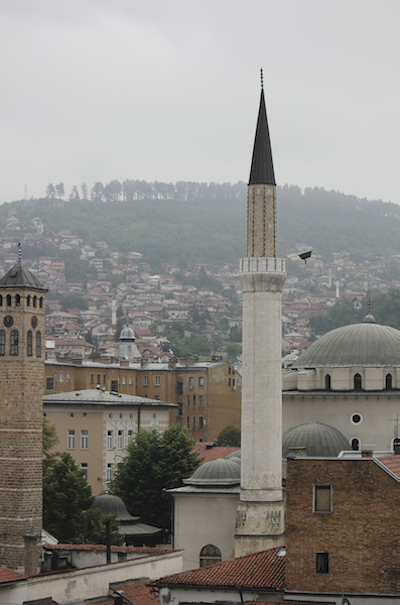 Sarajevo: Gazi Husrev-beg Mosque
Sarajevo: Gazi Husrev-beg Mosque
The next day we met our group and our two guides and were taken on a tour of the city. The local city guide was proud to point out that the cathedral, mosque and synagogue were all within a short walking distance of each other, indicative (he claimed) of the erstwhile religious tolerance that prevailed. Not surprisingly, peace themes and human rights feature largely in the psyche of the city, and an extensive outdoor exhibition, “Cartooning for Peace,” was on display along the banks of the Miljacka River while we were there.
From Sarajevo it took six hours of mountainous hairpin bends to reach Montenegro. Our destination that night was the city of Žabljak, within Durmitor National Park, Montenegro's largest. It's a breathtaking area of glacially carved mountains and lakes, and it is Montenegro's most important winter sports center. Our hotel was owned by a former Olympic skier, and photographs of him looking heroic on the slalom course featured prominently on the walls. Our night there coincided with the final of the 2014 World Cup, which we were determined to watch on the only television set available in the hotel. The commentary was not, of course, in English, and in wading into the question of what language it was in we run the risk of being immediately out of date. What they speak in Montenegro is essentially a dialect of Serbo-Croatian. It later became known simply as Serbian, but this offended the national pride of some people in Montenegro, and they succeeded in having the official language be known as “Montenegrin.” It's a distinction without much of a difference, at least as far as we were concerned.
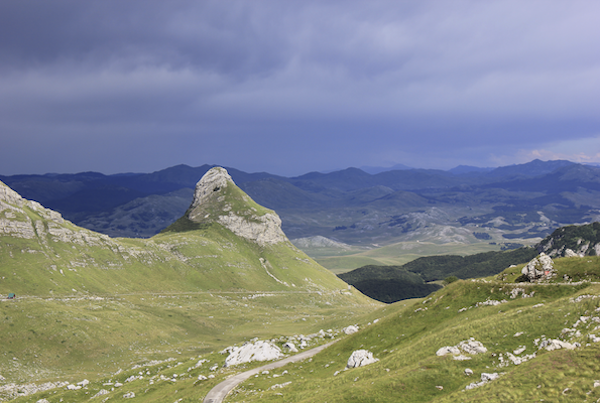 Montenegro: Durmitor National Park The next day we got our first exercise since walking around Sarajevo by hiking a circuit that took us to three very blue lakes set among pine forests. Wildflowers were at their peak, and we got our first view of the River Tara and its canyon. It claims to be the deepest in Europe, but in our experience a number of canyons make that same claim. We hoped we had misunderstood when we were told that dinner that night was to be a typical shepherd's meal because that was an experience that we thought we could live without. But it happened, as promised: polenta alone, polenta with cheese, polenta with butter, and then more polenta if you wanted it. That might be a Montenegrin shepherd's dream come true, but it wasn't ours.
Montenegro: Durmitor National Park The next day we got our first exercise since walking around Sarajevo by hiking a circuit that took us to three very blue lakes set among pine forests. Wildflowers were at their peak, and we got our first view of the River Tara and its canyon. It claims to be the deepest in Europe, but in our experience a number of canyons make that same claim. We hoped we had misunderstood when we were told that dinner that night was to be a typical shepherd's meal because that was an experience that we thought we could live without. But it happened, as promised: polenta alone, polenta with cheese, polenta with butter, and then more polenta if you wanted it. That might be a Montenegrin shepherd's dream come true, but it wasn't ours.
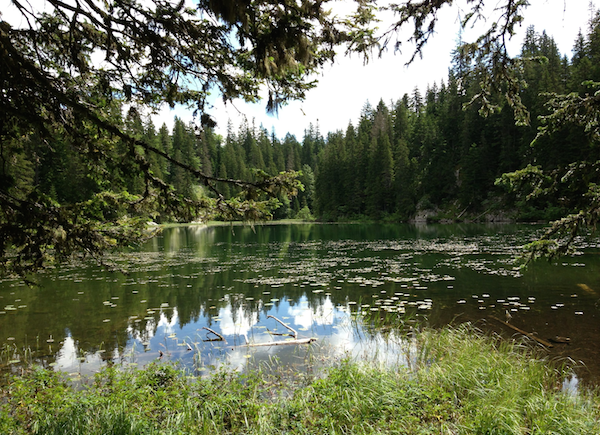 Montenegro: Lake BarnoThe River Tara crops up again and again in that part of the world. You can wonder at it, you can drive across it on a very high bridge, and you can raft down it. We did all three. And then there's a fourth option: you can cross the canyon on a zip line. When we were there the zip line had only been in operation for three weeks, and one of us wanted a much longer safety record established before entrusting her body to what the (teenaged) operators referred to as the “string.” But the price was too tempting for the other of us to pass up. Momentary misgivings when she was asked, seconds before being launched into space, how much she weighed, but she had little time to wonder why they wanted to know, and just hoped it had nothing to do with the tensile strength of the string. Sixty-six exhilarating seconds later it was over; she came hurtling towards the landing platform, where as many young men as necessary stood ready on the short platform to arrest her forward momentum. (Hence the need to know the weight: men vs. kilograms!)
Montenegro: Lake BarnoThe River Tara crops up again and again in that part of the world. You can wonder at it, you can drive across it on a very high bridge, and you can raft down it. We did all three. And then there's a fourth option: you can cross the canyon on a zip line. When we were there the zip line had only been in operation for three weeks, and one of us wanted a much longer safety record established before entrusting her body to what the (teenaged) operators referred to as the “string.” But the price was too tempting for the other of us to pass up. Momentary misgivings when she was asked, seconds before being launched into space, how much she weighed, but she had little time to wonder why they wanted to know, and just hoped it had nothing to do with the tensile strength of the string. Sixty-six exhilarating seconds later it was over; she came hurtling towards the landing platform, where as many young men as necessary stood ready on the short platform to arrest her forward momentum. (Hence the need to know the weight: men vs. kilograms!)
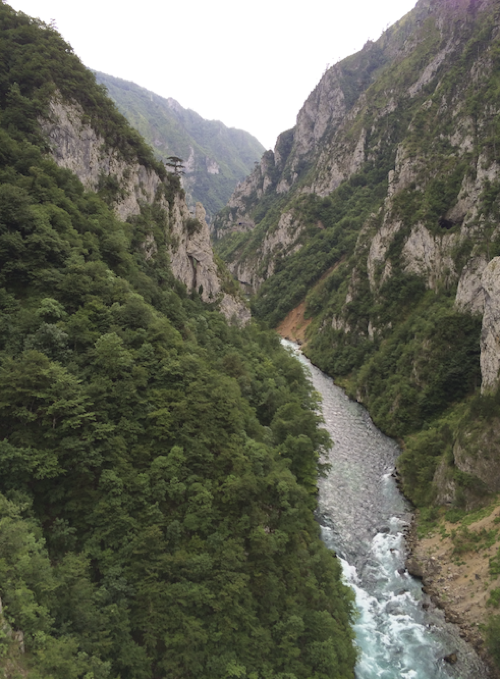 Tara River Canyon
Tara River Canyon
We passed another park, Biogradska Gora National Park, on our way to Kolašin, but the weather had deteriorated by then. Those with determination set out in the rain to walk around the primeval lake that was the featured attraction; others with just as much determination set out in the direction of a nearby park building that offered food and drink.
The bad weather seemed to have set in. The next day's hike was long and grueling – and wet. We had picnic lunches with us but in the rain we lacked the picnic place. After some swift rerouting our guides brought us to a shelter which looked promising enough but was already filled with people trying to save Ukraine. And they were expecting more to join them at any moment. Soaked and bedraggled as we were, we must have presented a convincingly pitiful appearance because after our guide had made a solemn promise to have us in and out in under ten minutes, we were allowed to sit and wolf down our lunches.
A bumpy, steeply upward hour-long drive brought us to the trailhead the next morning. From there it was a long, tough climb up to an exposed ridge, from which glorious views would have been possible had the weather cooperated.
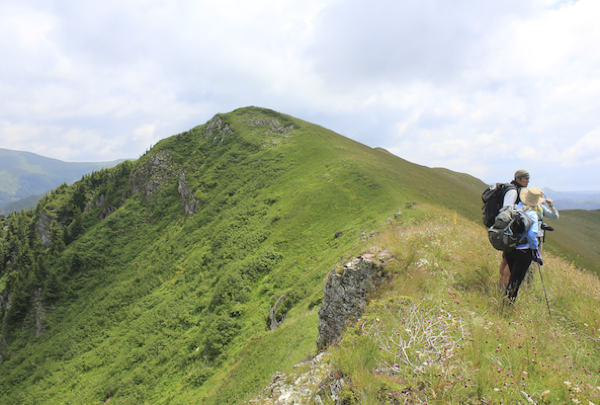 An exposed ridge, just before a change in the weather
An exposed ridge, just before a change in the weather
But rain became hail, lightning and thunder followed, and the weather turned quickly from cool to bitter cold. The guides made urgent adjustments and got us down off the ridge as rapidly as possible. We passed shepherds' villages, inaccessible in winter, before getting to what can only be described as a Montenegrin “camp” - two buildings that served as kitchen and dining area, and numerous small huts scattered about the hillside. We were soaking wet and freezing cold, and we filed into a dark and cheerless building. At that moment no five-star meal could have tasted better than what we were served: soup, unidentified meat, cabbage and peppers. And we ate potatoes that had been dug up only hours earlier, and that left us never again wanting to eat a potato any older than that.
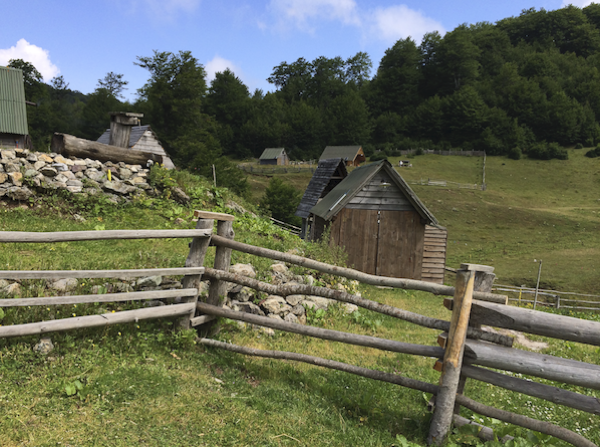 Shepherds' huts
Shepherds' huts
Being cold was not a problem when we hiked down to the floor of the canyon the next day. It got hotter and hotter as we descended towards the river, which we were always able to hear but could not see until the last minute because of the dense foliage. Finally we reached a steep, slippery slope, and by clutching onto bushes and small trees we were able to slither down to the rocks by the water's edge.
 At the bottom of the canyon
At the bottom of the canyon
A small, conscientious dog had joined our group several hours earlier and whenever we came to any questionable forks in the path he would wait patiently until he had us all where he wanted us before trotting off up ahead. Perhaps he did sheep herding in his spare time. It was as we sat happily by the river, sharing our lunches with the dog, that the ax fell: the guides divided us into two groups, sheep and goats. Sheep were deemed capable of doing the harder option, climbing to some rock “galleries” constructed during the war to protect the valley we were in. Goats (basically the two of us plus a couple others who probably felt pity for our having been so publicly identified as hopeless), were to take an easier path back up to the the waiting van. We would have plenty of rest stops along the way, so that both groups would get to the van at approximately the same time. In our defense, the little dog, whom we had come to regard as a Very Experienced and Sensible Guide, chose to join our group. But perhaps he only felt that we were the group more likely to need him to race ahead and get emergency assistance.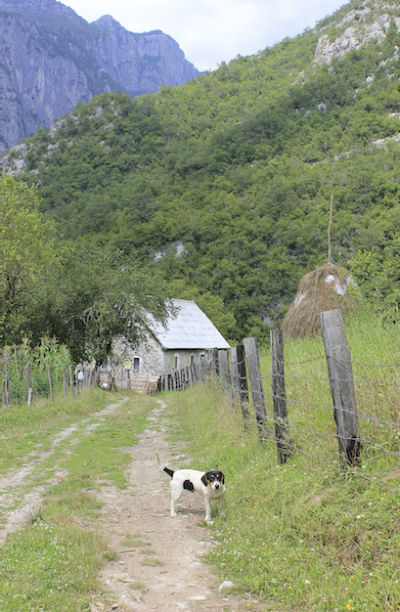 Our very conscientious local guide in the canyonSheep and goats met up for a restorative cold drink in a small cafe directly next to a highway. Huge, noisy, smelly trucks carrying lumber hurtled by continuously, and although none of us were sorry when it was time to leave, one man in our group couldn't get out of there fast enough. A very old woman, apparently a fixture in the cafe, wrinkled, slippered and toothless, had spotted and identified him as an American. She asked our guide whether or not he was married, and eagerly declared herself willing to have him if he wasn't. The prospect so rattled our fellow hiker that he stood up, leaving his drink unfinished, and hurriedly put as much distance between him and the lovesick lady as he could without risking being run over by a lumber truck. She seemed to accept the rejection with resignation; it probably was not the first she had experienced.
Our very conscientious local guide in the canyonSheep and goats met up for a restorative cold drink in a small cafe directly next to a highway. Huge, noisy, smelly trucks carrying lumber hurtled by continuously, and although none of us were sorry when it was time to leave, one man in our group couldn't get out of there fast enough. A very old woman, apparently a fixture in the cafe, wrinkled, slippered and toothless, had spotted and identified him as an American. She asked our guide whether or not he was married, and eagerly declared herself willing to have him if he wasn't. The prospect so rattled our fellow hiker that he stood up, leaving his drink unfinished, and hurriedly put as much distance between him and the lovesick lady as he could without risking being run over by a lumber truck. She seemed to accept the rejection with resignation; it probably was not the first she had experienced.
Soon after that we too were headed down that busy road, away from the mountains. We stopped to visit the Morača Monastery, a Serbian Orthodox monastery founded in 1252. A monk gave us a lot of information about it, its frescoes and some doorways, but in such broken English that the eyes began to glaze over. We listened politely, and then walked around the immaculately kept grounds. It was as tranquil as if time had stopped. The only audible signs of activity were the bees doing bee work in the many neat hives dotted around the lawns.
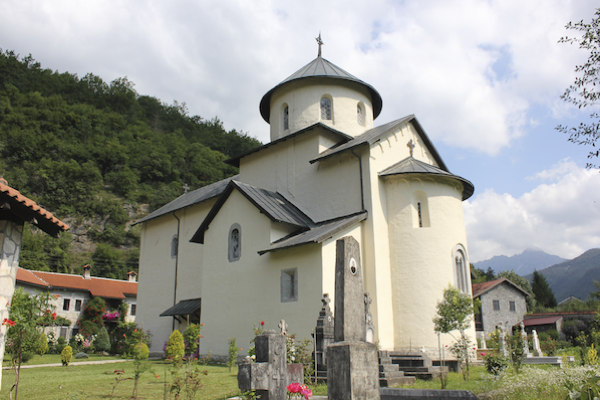 Morača MonasteryFrom there we descended rapidly towards Podgorica, the capital and largest city of Montenegro. The city was largely destroyed during the Second World War, and between 1946 and 1992 was known as Titograd. We didn't stop, but skirted it on our way to Virpazar, on the shore of Lake Skadar, the largest lake in the Balkan Peninsula.
Morača MonasteryFrom there we descended rapidly towards Podgorica, the capital and largest city of Montenegro. The city was largely destroyed during the Second World War, and between 1946 and 1992 was known as Titograd. We didn't stop, but skirted it on our way to Virpazar, on the shore of Lake Skadar, the largest lake in the Balkan Peninsula.
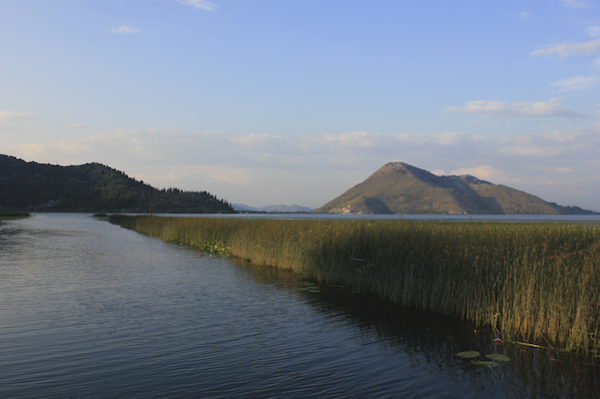 Lake Skadar
Lake Skadar
It straddlers a border: about two-thirds of it is within Montenegro and the other third is in Albania. The Montenegrin part of the lake was designated a national park in 1983, and its 270 species of birds include herons, pelicans, and cormorants. It is a paradise for birders, and also for fishermen. We had dinner that evening in a restaurant across the lake that was inaccessible by road. The boat left the small village of Virpazar and glided slowly through narrow waterways bordered on both sides by tall rushes, only picking up speed when we got onto the open lake. By the time we returned after a disappointing dinner it was dark but very clear, and a full moon illuminated the scene: hundreds of birds, some floating serenely on the water, others circling and diving with unfailing accuracy to seize fish.
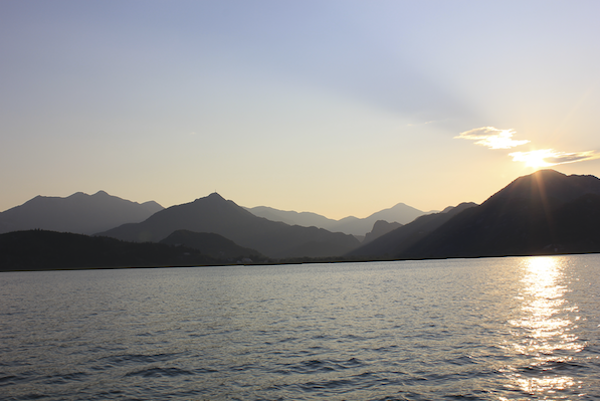 Lake Skadar, evening
Lake Skadar, evening
From Virpazar the drive to Kotor took us through largely uninhabited mountainous country bordering Lovćen National Park. We stopped in Cetinje, once the capital of Montenegro and still sometimes referred to as the “honorary” capital because of its rich cultural and historical heritage. There we visited the palace that was the home of Nikola, the last king of Montenegro. Elegant buildings that once housed embassies no longer do, but many of the gates still display the crests of those countries, and give some idea of the former importance of the now quiet city.
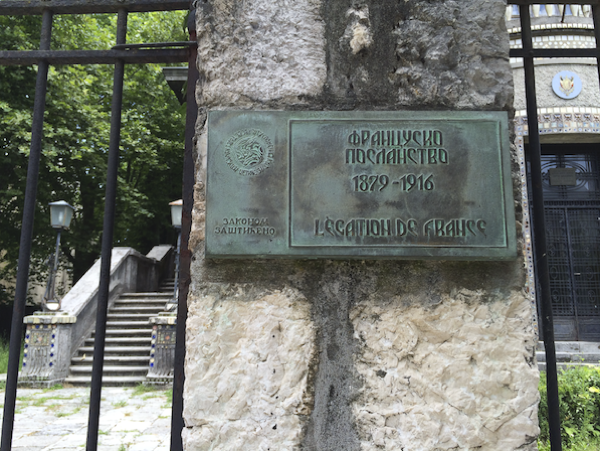 Cetinje; former French Embassy
Cetinje; former French Embassy
We stopped for lunch at a small hotel, sat on a lovely terrace, ate good bread and dependably good tomatoes, and...prosciutto. Again and again on this trip we had eaten prosciutto. And not even very good prosciutto. After an almost non-stop diet of it we asked our guides, very diplomatically so as not to hurt their feelings, why we had to have quite so much prosciutto. The response: in each area of the country it is made somewhat differently, and they wanted us to be able to sample the entire spectrum. In our opinion, the untrained palate neither can nor needs to be able to distinguish one Montenegrin prosciutto from another. We do not recommend going to Montenegro for the food. However, they pride themselves justifiably on their honey.
Soon after lunch, when we weren't mentally helping our very competent driver get the bus safely around hairpin bends, we began to get tantalizing glimpses down towards the Bay of Kotor. At one particularly fine overlook we got out of the bus to take photographs and down a glass of something resembling mead. (At least it had honey in it, that much we could tell). The air was getting hotter by the minute as we went steeply downwards towards the bay, and by the time we got to our hotel at water's edge, it felt like the tropics.
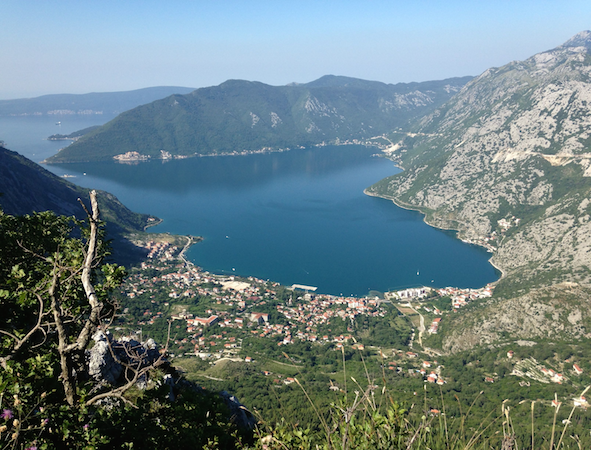 Overlooking Kotor BayWe took a walking tour through the walled, more than two thousand-year-old, city of Kotor, and listened attentively as our guide led us through its long and complicated history. Despite her best efforts and competent English, we will never get Turks, Ottomans, Illyrians, Venetians and Romans, and the part they played in the story of Kotor, correctly sorted out in our brains. But we did love the city itself. A protected UNESCO World Heritage site, it lies at the very end of the Bay of Kotor, near the Adriatic coast, in what is surely one of the most picture-perfect locations in the world. The city enchants, with its narrow, twisting alleys, small squares, and churches. And it has more than prosciutto to offer tourists! We had a memorable meal of mussels, octopus and risotto, on a lovely outdoor terrace.
Overlooking Kotor BayWe took a walking tour through the walled, more than two thousand-year-old, city of Kotor, and listened attentively as our guide led us through its long and complicated history. Despite her best efforts and competent English, we will never get Turks, Ottomans, Illyrians, Venetians and Romans, and the part they played in the story of Kotor, correctly sorted out in our brains. But we did love the city itself. A protected UNESCO World Heritage site, it lies at the very end of the Bay of Kotor, near the Adriatic coast, in what is surely one of the most picture-perfect locations in the world. The city enchants, with its narrow, twisting alleys, small squares, and churches. And it has more than prosciutto to offer tourists! We had a memorable meal of mussels, octopus and risotto, on a lovely outdoor terrace.
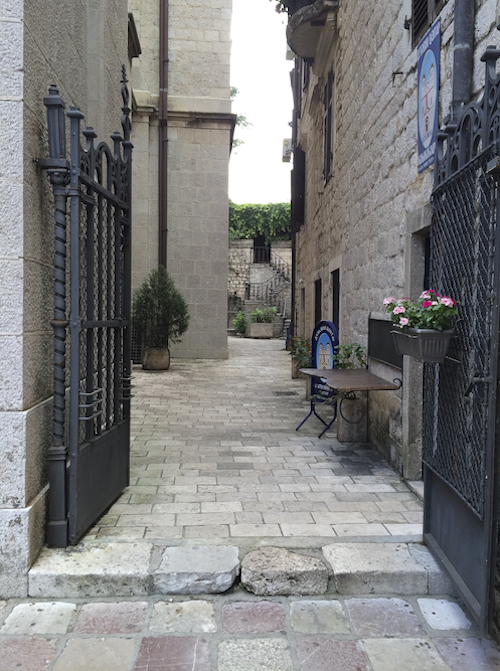 Kotor street scene
Kotor street scene
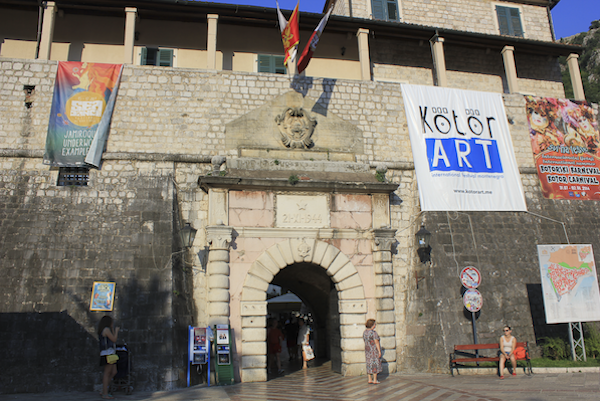 Kotor; entrance gate to the walled cityThe next day we had to stop being tourists and revert to being hikers. Starting out early in a futile attempt to beat the now oppressive heat, we drove steeply upwards into the mountains behind the bay to a small village. “Small” is an understatement; the village consisted of two people, one of whom was missing. The other welcomed us to his humble home, and invited anyone who didn't want to continue on the hike (to an old fortress quite a lot higher) to stay and visit with him. Visiting in what language, one might well ask? He had no takers. We all soldiered onwards and upwards, in punishing heat, to an abandoned Austro-Hungarian fortress overlooking the Bay of Kotor, far below.
Kotor; entrance gate to the walled cityThe next day we had to stop being tourists and revert to being hikers. Starting out early in a futile attempt to beat the now oppressive heat, we drove steeply upwards into the mountains behind the bay to a small village. “Small” is an understatement; the village consisted of two people, one of whom was missing. The other welcomed us to his humble home, and invited anyone who didn't want to continue on the hike (to an old fortress quite a lot higher) to stay and visit with him. Visiting in what language, one might well ask? He had no takers. We all soldiered onwards and upwards, in punishing heat, to an abandoned Austro-Hungarian fortress overlooking the Bay of Kotor, far below.
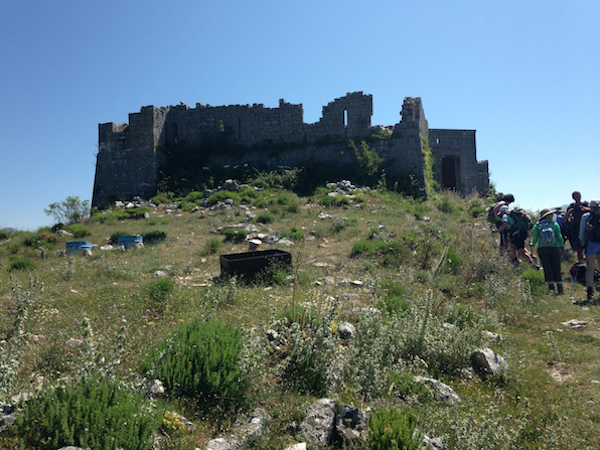 Abandoned Austro-Hungarian fortress overlooking Bay of Kotor Then came another sheep versus goats watershed, but this time we were very thankful to be put in the goat category. The sheep were going to walk the entire way down to the bay – three hours in more than 100° heat; we goats were merely going to struggle an hour or two back to the village where the bus was parked. It was a wise decision; the sheep returned completely shattered, whereas we goats had enough energy for a very pleasant return visit to Kotor. Both groups mustered up energy for a superb farewell dinner in the hotel's outdoor restaurant at water's edge.
Abandoned Austro-Hungarian fortress overlooking Bay of Kotor Then came another sheep versus goats watershed, but this time we were very thankful to be put in the goat category. The sheep were going to walk the entire way down to the bay – three hours in more than 100° heat; we goats were merely going to struggle an hour or two back to the village where the bus was parked. It was a wise decision; the sheep returned completely shattered, whereas we goats had enough energy for a very pleasant return visit to Kotor. Both groups mustered up energy for a superb farewell dinner in the hotel's outdoor restaurant at water's edge.
Our trip officially ended in Dybrovnik, some 40 scenic miles north up the coast from Kotor. It is in Croatia, so time to retire the Euros and kick one's self for not bringing any Dunas on the trip. Dubrovnik, nicknamed the “pearl of the Adriatic,” certainly deserves a visit, but try to go in the off-season. Or better yet, try to have gone fifty years ago. A summer day now - any summer day - is not the way to see it. On the other hand, there are not many hotels within the old city itself, and if you are fortunate enough to be staying in one, and can venture out at night after most of the crowds have left, it is quite magical. So we were told later. We had prudently booked a hotel closer to the airport so as to be sure not to miss our flight the next day, and it wasn't magical at all.
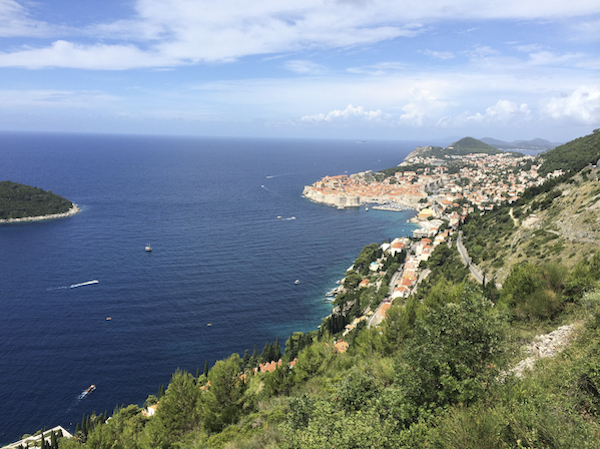 Dubrovnik, the “Pearl of the Adriatic" Our abiding memories of Montenegro are elusive. In some regards it was a study in contrasts: isolation in the hinterland and swarms of people in and around the coast; bitter cold in the higher elevations, and sweltering heat at sea level; some pretty impressive mountains and valleys, and far more impressive coastlines. We perhaps gained just enough insight into the politics of the region to know that we will never fully understand it. Montenegro won't be high on our bucket list, but it won't be the very bottom. There's always Morocco for that.
Dubrovnik, the “Pearl of the Adriatic" Our abiding memories of Montenegro are elusive. In some regards it was a study in contrasts: isolation in the hinterland and swarms of people in and around the coast; bitter cold in the higher elevations, and sweltering heat at sea level; some pretty impressive mountains and valleys, and far more impressive coastlines. We perhaps gained just enough insight into the politics of the region to know that we will never fully understand it. Montenegro won't be high on our bucket list, but it won't be the very bottom. There's always Morocco for that.

Reader Comments